An 8-day-old boy with jaundice
An 8-day-old male was referred for admission to the hospital by his primary provider for evaluation of jaundice with elevated liver enzymes and hepatomegaly. He has not been acting sick with emesis, diarrhea, respiratory symptoms or fever, but has had a nonspecific maculopapular rash that now appears to be in a desquamation phase. He has been eating normally with a diet of breast milk for the first few days, but has been on commercial cow’s milk formula since. There was no prenatal care, but the mother denied smoking, drug or alcohol abuse. This was the first pregnancy for this 22-year-old mother. She reports no significant health problems, but did admit to being treated for chlamydia about a year earlier. The social situation was poor, with mother and baby living with relatives. The baby was born vaginally at 38 weeks gestation at another hospital and received his first hepatitis B immunization along with hepatitis B immunoglobulin on the day of birth, and was discharged at 24 hours of age.
Examination upon arrival at the Children’s Hospital at Scott and White, his vital signs were normal. He was noted to have some mild scleral icterus and mild hepatomegaly. He also was noted to have some desquamation of his skin as shown in figures 1-4.

Pediatric Infectious Disease, Scott and White's Children's Health Center and Associate Professor of Pediatrics,
Texas A&M University, College of Medicine, Temple, Texas.
e-mail: jhbrien@aol.com
Lab tests on admission included a complete blood count (CBC) showing a white blood cell count of 20,300 and otherwise normal. His liver enzymes revealed an serum glutamic oxaloacetic transaminase (SGOT) of 250 and serum glutamic pyruvic transaminase (SGPT) of 274 and alkaline phosphatase of 556.
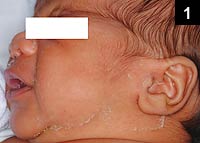

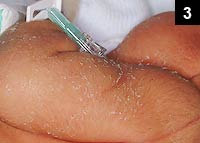
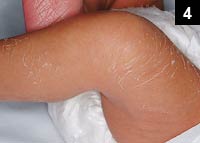

What’s Your Diagnosis? HINT - see figure 5.
- Congenital cytomegalovirus (CMV) infection
- Congenital syphilis
- Congenital toxoplasmosis
- Neonatal herpes simplex virus (HSV) infection
Answer
The hint reveals the classic finding of Wimberger’s sign, the radiolucent appearance of the medial aspect of the proximal tibias that is characteristic in congenital syphilis (B).

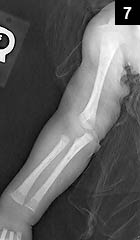
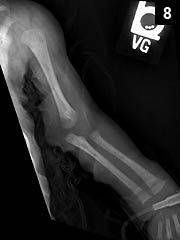

Heinrich Wimberger was a German radiologist during the 20th Century, describing this virtually pathognomonic sign of congenital syphilis. Other classic bony features are periostitis of the long bones and decreased mineralization of the metaphyses of all the long bones (figures 6-8). Other supportive features of congenital syphilis in this baby include the rash with desquamation, liver enlargement, jaundice and elevated enzymes. Other lab tests done included a normal spinal fluid analysis with a negative venereal disease research laboratory slide test (VDRL), a positive serum VDRL at a ratio of 1:16 and a positive fluorescent treponemal antibodies absorption (FTA-ABS) test. Of course, the FTA-ABS in the baby could be a measure of mothers antibodies passively transferred before birth.

Prenatal care has made congenital syphilis very uncommon in this country. When seen, it’s likely to be in a baby whose mother did not receive prenatal care, and is even more likely in one who has had other sexually transmitted infections, such as chlamydia in this baby’s mother. After completing his antibiotic therapy (150,000 units of penicillin G per kg/day, divided q eight-hours for 10 days), his bone abnormalities began to resolve, as shown in the follow up images done one month later (figures 9-10).
Congenital CMV infection is usually asymptomatic at birth, but may result in early neurologic symptoms with intracranial calcifications, as shown in figure 11, revealing the typical periventricular pattern. This differs from congenital toxoplasmosis in that the calcifications of toxo tend to be scattered throughout the brain, as shown in figure 12. Chorioretinitis can complicate both, and decreased vision may be the presenting complaint at several months of age.

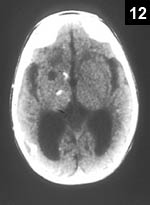
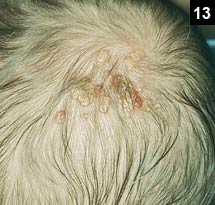
Neonatal herpes simplex virus infection usually has some skin findings, consisting of a variety of lesions from macular, papular, pustular and vesicular lesions, often occurring in clusters as shown in figure 13. This skin infection is not likely to result in diffuse desquamation, as shown in this case, and not likely to have associated bone abnormalities. Of course, neonatal HSV infection can present without skin manifestations, as in CNS (central nervous system) disease for example.
To read more about congenital syphilis, I recommend the Red Book for a quick reference, or Sara Long’s textbook, Principles and Practice of Pediatric Infectious Diseases for a more in-depth review.
Commentary
The radiographic findings of congenital syphilis was the subject of my first question on my oral pediatric board exam in 1981. I missed it. My excuse was, I never saw a case during my Army Pediatric residency or in my brief career at that time in the Army at Fort Hood, Texas. Of course, that’s no reason not to know the answer, but the fact is, pregnancy without prenatal care in military families is very unusual. It is one of the many advantages of medical care in the military. But it does limit the experience military physicians get in these sorts of preventable problems. However, their talents in all other areas are broad and deep.
As I have mentioned in recent issues, the election of the next president of the AAP is an important activity for the AAP membership. The time is now upon us to make our choice of president, as well as six out of 10 district officers, and have a voice in the future direction of the Academy. The two candidates for President are David T. Tayloe, Jr., MD, FAAP, of Goldsboro, North Carolina, and James E. Shira, MD, FAAP, Colonel, Medical Corps, U.S. Army (retired), of Denver, Colorado. You can review the biographies of these excellent candidates, and those of the District-level candidates at the AAP website, www.aap.org. If you have not done so already, please send in your ballot. Either vote, or don’t complain if you don’t like the way things are going.
What’s Your Diagnosis? is a monthly case study featured in Infectious Diseases in Children, with treatment information and discussion to follow.
